List of paintings
| Image | Year Title | Gallery Country | Technique Dimensions (cm) |
|---|---|---|---|
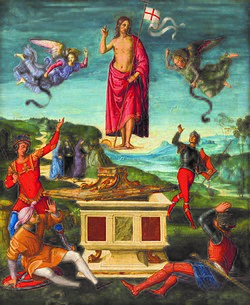 | 1499–1502: Resurrection of Christ | São Paulo Museum of Art, Brazil | Oil on panel 57 x 47 |
 | c. 1499: Banner of the Holy Trinity | Pinacoteca Comunale, Città di Castello | Oil on canvas 166 x 94 |
 | c. 1499: The Creation of Eve from Adam's Rib | Pinacoteca Comunale, Città di Castello | Oil on canvas 166 x 94 |
 | 1500-1501: Baronci Altarpiece | Pinacoteca Comunale, Città di Castello | Oil on panel |
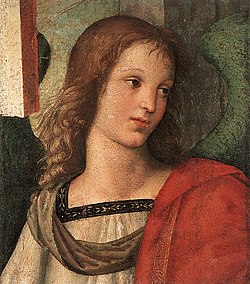 | 1500–1501: Angel | Pinacoteca Civica Tosio Martinengo, Brescia, Italy | Oil on canvas transferred from panel 31 x 26 |
 | 1500–1501: Angel Holding a Scroll | Louvre, Paris, France | Oil on panel 58 x 36 |
 | 1500–1501: God the Father and the Virgin Mary | Museo di Capodimonte, Naples, Italy | Tempera on panel 110 x 73 |
 | 1501–1502: Saint Sebastian | Accademia Carrara di Belle Arti di Bergamo, Italy | Oil on panel 45,1 x 36,5 |
 | c. 1502: Portrait of a Man | Galleria Borghese, Rome, Italy | Oil on panel 45 x 31 |
 | c. 1502: Madonna and Child between Saints Jerome and Francis | Gemäldegalerie, Berlin, Germany | Oil on panel 34 x 29 |
 | c. 1502: Solly Madonna | Gemäldegalerie, Berlin, Germany | Oil on panel 52 x 38 |
 | 1502–1503: Madonna and Child with the Book | Norton Simon Museum, Pasadena, United States | Oil on panel 55,2 x 40 |
 | 1502–1503: Mond Crucifixion | National Gallery, London, United Kingdom | Oil on panel 283,3 x 167,3 |
 | 1502–1503: Saint Eusebius Resurrecting Three People | National Museum of Ancient Art, Lisbon, Portugal | Oil on panel 25,6 x 43,9 |
 | 1503: Saint Jerome Punishing the Heretic Sabinian | North Carolina Museum of Art, Raleigh, United States | Oil on panel 25,7 x 41,9 |
 | 1502–1504: Coronation of the Virgin | Vatican Museums, Vatican City | Tempera on panel transferred to canvas 272 x 165 |
 | 1502–1504: The Annunciation | Vatican Museums, Vatican City | Tempera on panel 27 x 50 |
 | 1502–1504: The Adoration of the Magi | Vatican Museums, Vatican City | Tempera on panel 27 x 50 |
 | 1502–1504: The Presentation in the Temple | Vatican Museums, Vatican City | Tempera on panel 27 x 50 |
 | c. 1503: Diotallevi Madonna | Gemäldegalerie, Berlin, Germany | Oil on panel 69 x 50 |
 | c. 1503: Self-Portrait | Alte Pinakothek, Munich, Germany | [1] [a] |
 | 1503–1504: Young Man with an Apple | Uffizi, Florence, Italy | Tempera on panel 48 x 35,5 |
 | 1503–1505: Saint George | Louvre, Paris, France | Oil on panel 29 x 25 |
 | 1503–1505: Saint Michael | Louvre, Paris, France | Oil on panel 30 x 26 |
 | 1503–1505: Portrait of Pietro Bembo | Museum of Fine Arts (Budapest), Hungary | Oil on panel 54 x 39 |
 | 1504 | Uffizi, Florence | Tempera on wood 57 × 42 |
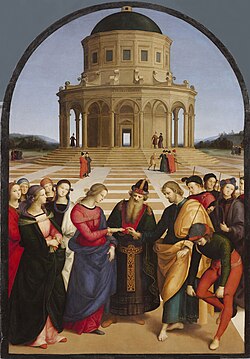 | 1504: The Marriage of the Virgin | Pinacoteca di Brera, Milan, Italy | Oil on panel 170 x 117 |
 | 1504: Conestabile Madonna | Hermitage Museum, Saint Petersburg, Russia | Tempera on canvas transferred from panel 17,5 x 18 |
 | c. 1504 Madonna and Child Enthroned with Saints | Metropolitan Museum of Art, New York, United States | Oil and gold on panel 169,5 x 168,9 |
 | c. 1504 The Agony in the Garden | Metropolitan Museum of Art, New York, United States | Oil on panel 24,1 x 28,9 |
 | 1504–1505 The Procession to Calvary | National Gallery, London, United Kingdom | Oil on panel 24,4 x 85,5 |
 | Lamentation over the Dead Christ | Isabella Stewart Gardner Museum, Boston, United States | Oil on panel 23,5 x 28,8 |
 | c. 1504: Saint Francis of Assisi | Dulwich Picture Gallery, London, United Kingdom | Oil on panel 25 x 16 |
 | c. 1504: Saint Anthony of Padua | Dulwich Picture Gallery, United Kingdom | Oil on panel 25 x 16 |
 | c. 1504 An Allegory ('Vision of a Knight') | National Gallery, London, United Kingdom | Oil on panel 17,1 x 17,3 |
 | c. 1504 Three Graces | Musée Condé, Chantilly, France | Oil on panel 17 x 17 |
 | 1504–1505 | Uffizi, Florence | Oil on wood 52.9 × 37.4 |
 | 1504–1505 | Baltimore Museum of Art, Baltimore | Oil on wood 58 × 36 |
 | 1504–1505 Madonna del Granduca | Palazzo Pitti, Florence, Italy | Oil on panel 84,4 x 55,9 |
 | 1505: Ansidei Madonna | National Gallery, London, United Kingdom | Oil on panel 216,8 x 147,6 |
 | 1505: Saint John the Baptist Preaching | National Gallery, London, United Kingdom | Oil on panel 26,2 x 52 |
 | c. 1505 Small Cowper Madonna | National Gallery of Art, Washington, United States | Oil on panel 59,5 x 44 |
 | c. 1505: Terranuova Madonna | Gemäldegalerie, Berlin, Germany | Oil on panel Diameter 88,5 |
 | 1505–1506: Christ Blessing | Pinacoteca Civica Tosio Martinengo, Brescia, Italy | Oil on panel 32 x 25 |
 | 1505–1506: Madonna of the Goldfinch | Uffizi, Florence, Italy | Tempera on panel 107 x 77 |
 | 1505–1506: Madonna of the Meadow | Kunsthistorisches Museum, Vienna, Austria | Oil on panel 113 x 88,5 |
 | 1505–1506: La Donna Gravida | Palazzo Pitti, Florence, Italy | Oil on panel 68,8 x 52,6 |
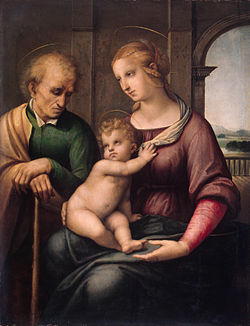 | 1505–1507: Madonna with Beardless Saint Joseph | Hermitage Museum, Saint Petersburg, Russia | Tempera on canvas, transferred from panel 72,5 x 56,5 |
 | 1506 | Uffizi, Florence | Oil on wood 69 × 52 |
 | 1506: Portrait of Agnolo Doni | Uffizi, Florence, Italy | Oil on panel 63 x 45 |
 | 1506: Portrait of Maddalena Doni | Uffizi, Florence, Italy | Oil on panel 63 x 45 |
 | 1506: Lady with a Unicorn | Galleria Borghese, Rome, Italy | Oil on panel 65 x 51 |
 | 1506: The Holy Family With a Palm Tree | Scottish National Gallery, Edinburgh, United Kingdom | Oil and gold on canvas transferred from panel diameter 101,5 |
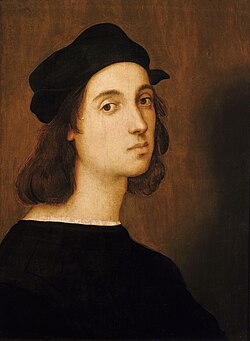 | c. 1506: Self-portrait | Palazzo Pitti, Florence, Italy | Tempera on panel 47,5 x 33 |
 | c. 1506: Saint George and the Dragon | National Gallery of Art, Washington, United States | Oil on panel 28,5 x 21,5 |
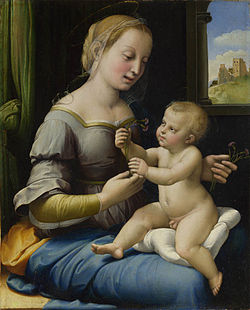 | 1506–1507: The Madonna of the Pinks ('La Madonna dei Garofani') | National Gallery, London, United Kingdom | Oil on panel 27,9 x 22,4 |
 | 1507: Canigiani Holy Family | Alte Pinakothek, Munich, Germany | Oil on panel 131 x 107 |
 | 1507: The Holy Family with a Lamb | Museo del Prado, Madrid, Spain | Oil on panel 28 x 21,5 |
 | 1507: La Madonna de Bogota (Madonna with the Child) | NY Bank Vault, New York, United States | ? |
 | 1507: The Deposition | Galleria Borghese, Rome, Italy | Oil on panel 184 x 176 |
 | 1507: Faith, Hope and Charity [2] | Vatican Museums, Vatican City | Tempera on panel 18 x 44 each |
 | c. 1507: Orléans Madonna | Musée Condé, Chantilly, France | Oil on panel 29 x 21 |
 | c. 1507: Saint Catherine of Alexandria | National Gallery, London, United Kingdom | Oil on panel 72,2 x 55,7 |
 | c. 1507: Bridgewater Madonna | Scottish National Gallery, Edinburgh, United Kingdom | Oil and gold on canvas, transferred from panel 81 x 55 |
 | c. 1507: Portrait of a Young Woman (La Muta) | Galleria Nazionale delle Marche, Urbino, Italy | Oil on panel 64 x 48 |
 | 1507–1508: The Virgin and Child with the Infant Saint John the Baptist (La belle jardinière) | Louvre, Paris, France | Oil on panel 122 x 80 |
 | 1507–1508: Madonna of the Baldacchino | Palazzo Pitti, Florence, Italy | Oil on canvas 279 x 217 |
 | 1507–1508: Colonna Madonna | Gemäldegalerie, Berlin, Germany | Oil on panel 52 x 38 |
 | 1508: Tempi Madonna | Alte Pinakothek, Munich, Germany | Oil on panel 75 x 51 |
 | 1508: Niccolini-Cowper Madonna | National Gallery of Art, Washington, United States | Oil on panel 80,7 x 57,5 |
 | 1508: Esterhazy Madonna | Museum of Fine Arts, Budapest, Hungary | Tempera and oil on panel 28,5 × 21,5 |
 | c. 1509: Portrait of Tommaso Inghirami | Palazzo Pitti, Florence, Italy | Oil on panel 89,5 x 62,8 |
 | c. 1509: Portrait of Tommaso Inghirami | Isabella Stewart Gardner Museum, Boston, United States | Oil on panel 89,7 x 62,2 |
 | 1509–1510: Garvagh Madonna | National Gallery, London, United Kingdom | Oil on panel 38,9 x 32,9 |
 | 1509–1510: La Disputa | Vatican Museums, Vatican City | Fresco 500 x 770 |
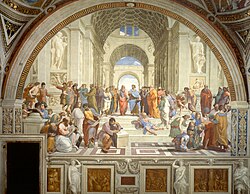 | 1509–1510: The School of Athens | Vatican Museums, Vatican City | Fresco 500 x 770 |
 | 1509–1510: Madonna of Loreto | Musée Condé, Chantilly, France | Oil on panel 120 x 90 |
 | 1509–1511: Mackintosh Madonna | National Gallery, London, United Kingdom | Oil (almost entirely repainted) on canvas, transferred from panel 78,8 x 64,2 |
 | 1509–1511: Portrait of Cardinal Alessandro Farnese | Museo di Capodimonte, Naples, Italy | Oil on panel 139 x 91 |
 | c. 1510: Alba Madonna | National Gallery of Art, Washington, United States | Oil on panel transferred to canvas diameter 94,5 |
 | 1510–1511: The Cardinal | Museo del Prado, Madrid, Spain | Oil on panel 79 x 61 |
 | 1511: The Parnassus | Vatican Museums, Vatican City | Fresco ? x 670 |
 | 1511: The Cardinal Virtues | Vatican Museums, Vatican City | Fresco ? x 660 |
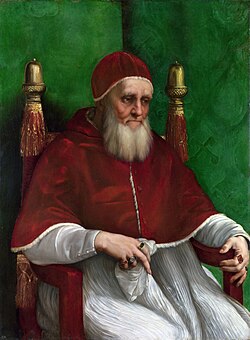 | 1511: Portrait of Pope Julius II | National Gallery, London, United Kingdom | Oil on panel 108,7 x 81 |
 | 1511–1512: The Prophet Isaiah | Basilica of Sant'Agostino, Rome, Italy | Fresco 250 x 155 |
 | 1511–1512: The Expulsion of Heliodorus from the Temple | Vatican Museums, Vatican City | Fresco ? x 750 |
 | 1511–1512: Madonna of Foligno | Vatican Museums, Vatican City | Tempera on panel transferred onto canvas 308 x 198 |
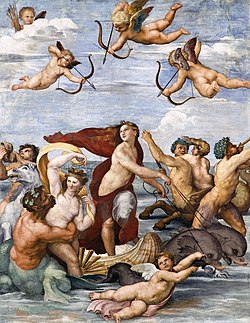 | 1511–1513: The Triumph of Galatea | Villa Farnesina, Rome, Italy | Fresco 750 x 570 |
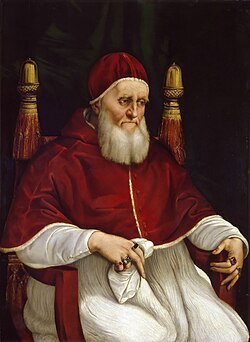 | c. 1512: Portrait of Pope Julius II | Uffizi, Florence, Italy | Oil on panel 108,5 x 80 |
 | 1512–1513: Sistine Madonna | Gemäldegalerie Alte Meister, Dresden, Germany | Oil on canvas 265 х 196 |
 | 1513: [3] Madonna of Leo X [3] [4] | Private collection, Zurich, Switzerland [3] | Oil on canvas 119 x 82,5 [3] |
 | c. 1513: Madonna of the Candelabra | Walters Art Museum, Baltimore, United States | Oil on panel 65,7 х 64 |
 | 1513–1514: Madonna with the Fish | Museo del Prado, Madrid, Spain | Oil on panel 215 x 158 |
 | 1513–1514: Madonna della seggiola (Madonna and Child with the Infant Saint John the Baptist) | Palazzo Pitti, Florence, Italy | Oil on panel diameter 71 |
 | 1513–1514: Madonna dell'Impannata | Palazzo Pitti, Florence, Italy | Oil on panel 160 x 127 |
 | 1513–1514 | Czartoryski Museum, Kraków, Poland | oil on panel 72 × 56 |
 | 1514: Madonna della tenda | Alte Pinakothek, Munich, Germany | Oil on panel 65,8 x 51,2 |
 | 1514: The Sibyls | Santa Maria della Pace, Rome, Italy | Fresco x 615 |
 | 1514–1515: Portrait of Baldassare Castiglione | Louvre, Paris, France | Oil on canvas 82 x 67 |
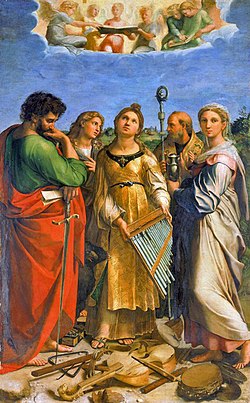 | 1514–1515: Ecstasy of Saint Cecilia Between Saints Paul, John Evangelist, Augustine and Mary Magdalene | Pinacoteca Nazionale di Bologna, Italy | Oil on panel transferred to canvas 236 x 139 |
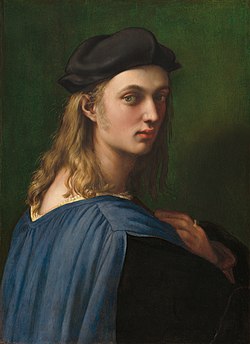 | c. 1515: Portrait of Bindo Altoviti | National Gallery of Art, Washington, United States | Oil on panel 59,7 x 43,8 |
 | 1515–1516: Christ Falls on the Way to Calvary | Museo del Prado, Madrid, Spain | Oil on panel 318 x 229 |
 | 1515–1516: Woman with a Veil (La donna velata) | Palazzo Pitti, Florence, Italy | Oil on canvas 82 x 60,5 |
 | c. 1516: Portrait of Cardinal Bibbiena | Palazzo Pitti, Florence, Italy | Oil on canvas 85 x 66,3 |
 | c. 1516: Portrait of Andrea Navagero and Agostino Beazzano | Doria Pamphilj Gallery, Rome, Italy | Oil on canvas 77 x 111 |
 | c. 1516: Madonna del Passeggio | Scottish National Gallery, Edinburgh, United Kingdom | Oil and gold on panel 90 x 63,3 |
 | 1516 | Chigi Chapel, Rome | |
 | 1516-1517 | Louvre, Paris | Oil on canvas transferred from panel 135 × 142 |
 | c. 1517: Visitation | Museo del Prado, Madrid, Spain | Oil on panel 200 x 145 |
 | 1510-1518 | Louvre, Paris | Oil on wood 68 × 48 |
 | 1518-1520: Madonna of the Rose | Museo del Prado, Madrid, Spain | Oil on canvas 103 x 84 |
 | 1518: Holy Family of Francis I | Louvre, Paris, France | Oil on canvas transferred from panel 207 x 140 |
 | 1518: The Vision of Ezekiel | Palazzo Pitti, Florence, Italy | Oil on panel 40,7 x 29,5 |
 | 1518: Saint Michael Vanquishing Satan | Louvre, Paris, France | Oil on canvas transferred from panel 268 x 160 |
 | c. 1518: Saint Margaret and the Dragon | Kunsthistorisches Museum, Vienna, Austria' | Oil on panel 192 x 122 |
 | 1518 | Louvre, Paris | Oil on panel 178 x 122 |
 | c. 1518: Portrait of a Young Woman | Musée des Beaux-Arts de Strasbourg, France | Oil on panel 60 x 40 |
 | c. 1518: Portrait of Lorenzo de' Medici, Duke of Urbino | Private collection | Oil on canvas 97.2 × 79.4 |
 | c. 1518: Pope Leo X with Cardinals Giulio de' Medici and Luigi de' Rossi | Uffizi, Florence, Italy | Tempera on panel 155,5 x 119,5 |
 | c. 1518: The Pearl [5] | Museo del Prado, Madrid, Spain | Oil on panel 147,4 x 116 |
 | 1518 Portrait of Doña Isabel de Requesens y Enríquez de Cardona-Anglesola | Louvre, Lens | Oil on panel 120 × 95 |
 | 1518–1519: Self-portrait with a Friend | Louvre, Paris, France | Oil on canvas 99 x 83 |
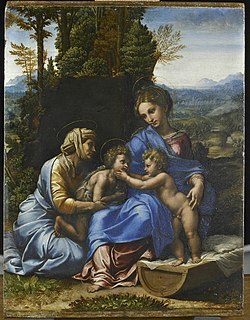 | 1518–1519 | Louvre, Paris | Oil on panel 38 × 32 |
 | 1518–1520: Holy Family Under an Oak Tree | Museo del Prado, Madrid, Spain | Oil on panel 144 x 110 |
 | 1520: La fornarina | Palazzo Barberini, Rome, Italy | Oil on panel 87 x 63 |
 | 1516–1520: The Transfiguration | Vatican Museums, Vatican City | Tempera on panel 410 x 279 |